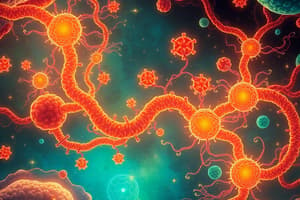Podcast
Questions and Answers
What happens in Step 1 of Glycolysis?
What happens in Step 1 of Glycolysis?
- A phosphate group is transferred from ATP to glucose (correct)
- Glucose is converted to fructose
- Dihydroxyacetone phosphate is produced
- Fructose-1,6-bisphosphate is formed
What enzyme catalyzes Step 1 of Glycolysis?
What enzyme catalyzes Step 1 of Glycolysis?
Hexokinase
What is produced in Step 2 of Glycolysis?
What is produced in Step 2 of Glycolysis?
- Fructose-6-phosphate (correct)
- Dihydroxyacetone phosphate
- Glucose-6-phosphate
- Fructose-1,6-bisphosphate
What enzyme is involved in Step 2?
What enzyme is involved in Step 2?
What occurs in Step 3 of Glycolysis?
What occurs in Step 3 of Glycolysis?
Which enzyme regulates Step 3 of Glycolysis?
Which enzyme regulates Step 3 of Glycolysis?
What happens in Step 4 of Glycolysis?
What happens in Step 4 of Glycolysis?
What enzyme is responsible for the reaction in Step 4?
What enzyme is responsible for the reaction in Step 4?
What occurs in Step 5 of Glycolysis?
What occurs in Step 5 of Glycolysis?
Which enzyme catalyzes Step 5?
Which enzyme catalyzes Step 5?
What is produced in Step 6 of Glycolysis?
What is produced in Step 6 of Glycolysis?
What is the function of the enzyme in Step 6?
What is the function of the enzyme in Step 6?
What action does Step 7 of Glycolysis accomplish?
What action does Step 7 of Glycolysis accomplish?
Which enzyme is involved in Step 7?
Which enzyme is involved in Step 7?
What transformation occurs in Step 8 of Glycolysis?
What transformation occurs in Step 8 of Glycolysis?
What enzyme is used in Step 8?
What enzyme is used in Step 8?
What occurs in Step 9 of Glycolysis?
What occurs in Step 9 of Glycolysis?
What enzyme is involved in Step 9?
What enzyme is involved in Step 9?
What happens in Step 10 of Glycolysis?
What happens in Step 10 of Glycolysis?
What enzyme facilitates Step 10 of Glycolysis?
What enzyme facilitates Step 10 of Glycolysis?
Regulatory Step #1 of Glycolysis is reversible.
Regulatory Step #1 of Glycolysis is reversible.
Regulatory Step #2 involves an allosteric enzyme.
Regulatory Step #2 involves an allosteric enzyme.
Regulatory Step #3 of Glycolysis is highly endergonic.
Regulatory Step #3 of Glycolysis is highly endergonic.
Flashcards are hidden until you start studying
Study Notes
Glycolysis Overview
- Glycolysis occurs in the cytosol and is the metabolic pathway that converts glucose into pyruvate, producing ATP and NADH.
- It is divided into two phases: the energy investment phase and the payoff phase.
Step 1: Glucose Phosphorylation
- Glucose is phosphorylated by ATP to form glucose-6-phosphate.
- Enzyme: Hexokinase.
- Glucose-6-phosphate is more reactive and is unable to cross the membrane, trapping it inside the cell.
Step 2: Isomerization
- Glucose-6-phosphate is converted into fructose-6-phosphate.
- Enzyme: Phosphoglucose Isomerase.
Step 3: Second Phosphorylation
- Fructose-6-phosphate is phosphorylated using ATP to form fructose-1,6-bisphosphate.
- Enzyme: Phosphofructokinase (PFK).
- PFK is an allosteric enzyme that regulates glycolysis based on energy needs.
Step 4: Cleavage
- Fructose-1,6-bisphosphate splits into two three-carbon sugars: dihydroxyacetone phosphate (DHAP) and glyceraldehyde-3-phosphate (G3P).
- Enzyme: Fructose Biphosphate Aldolase.
- Only G3P can continue in the glycolysis pathway.
Step 5: Isomerization of DHAP
- DHAP is converted to G3P, with the equilibrium favoring G3P consumption.
- Enzyme: Triose Phosphate Isomerase.
- Marks the end of the energy investment phase, having consumed two ATP.
Step 6: Oxidation and Phosphorylation
- G3P is oxidized, reducing NAD+ to NADH and forming 1,3-bisphosphoglycerate.
- Enzyme: Glyceraldehyde-3-Phosphate Dehydrogenase.
- This reaction generates energy for phosphorylation.
Step 7: Substrate-Level Phosphorylation
- 1,3-bisphosphoglycerate transfers a phosphate to ADP, producing ATP and forming 3-phosphoglycerate.
- Enzyme: Phosphoglycerate Kinase.
- This is the first substrate-level phosphorylation of glycolysis.
Step 8: Isomerization
- 3-phosphoglycerate is converted to 2-phosphoglycerate.
- Enzyme: Phosphoglycerate Mutase.
Step 9: Dehydration
- Water is removed from 2-phosphoglycerate, creating phosphoenolpyruvate (PEP), which is unstable.
- Enzyme: Enolase.
Step 10: Final Phosphorylation
- PEP donates its phosphate to ADP, yielding another ATP and forming pyruvate.
- Enzyme: Pyruvate Kinase.
- This final step concludes the payoff phase with a net gain of 2 ATP per glucose.
Regulatory Steps
- Step 3 by Phosphofructokinase: First irreversible and highly exergonic, speeding up or slowing glycolysis.
- Step 10 by Pyruvate Kinase: Final irreversible and highly exergonic, contributing to metabolic control.
- Regulation of these steps ensures the glycolysis pathway is adjusted based on cellular energy status.
Studying That Suits You
Use AI to generate personalized quizzes and flashcards to suit your learning preferences.




